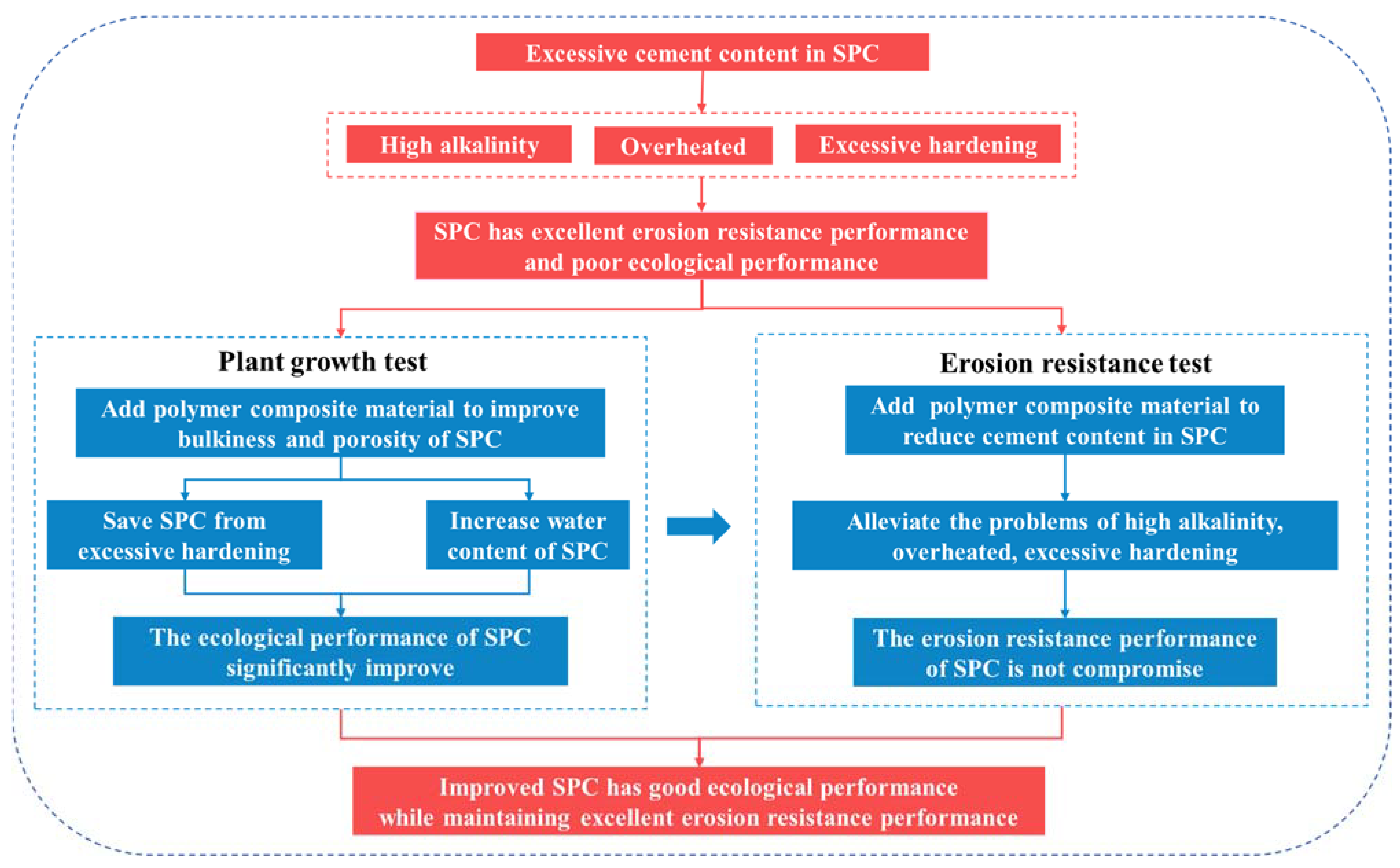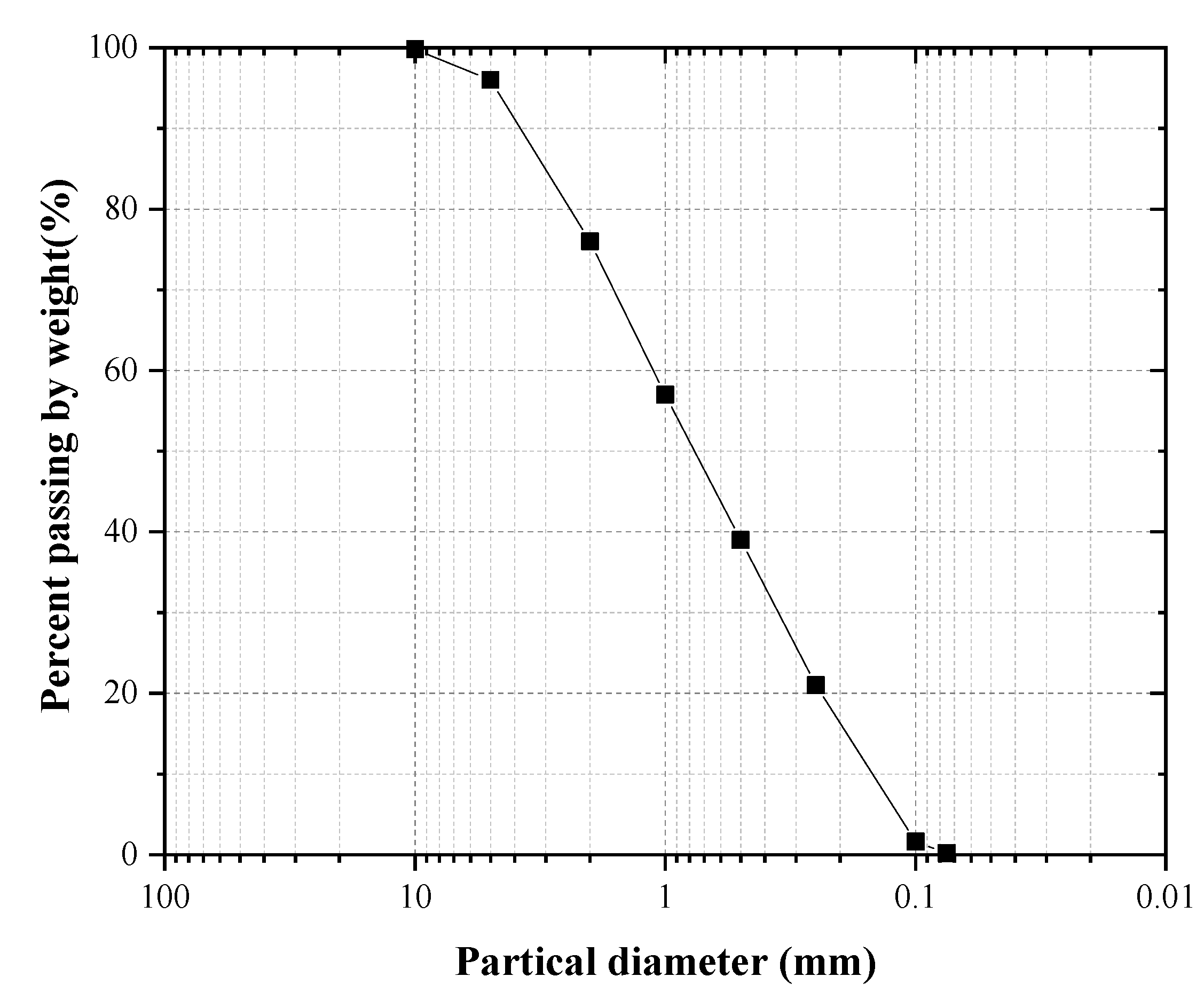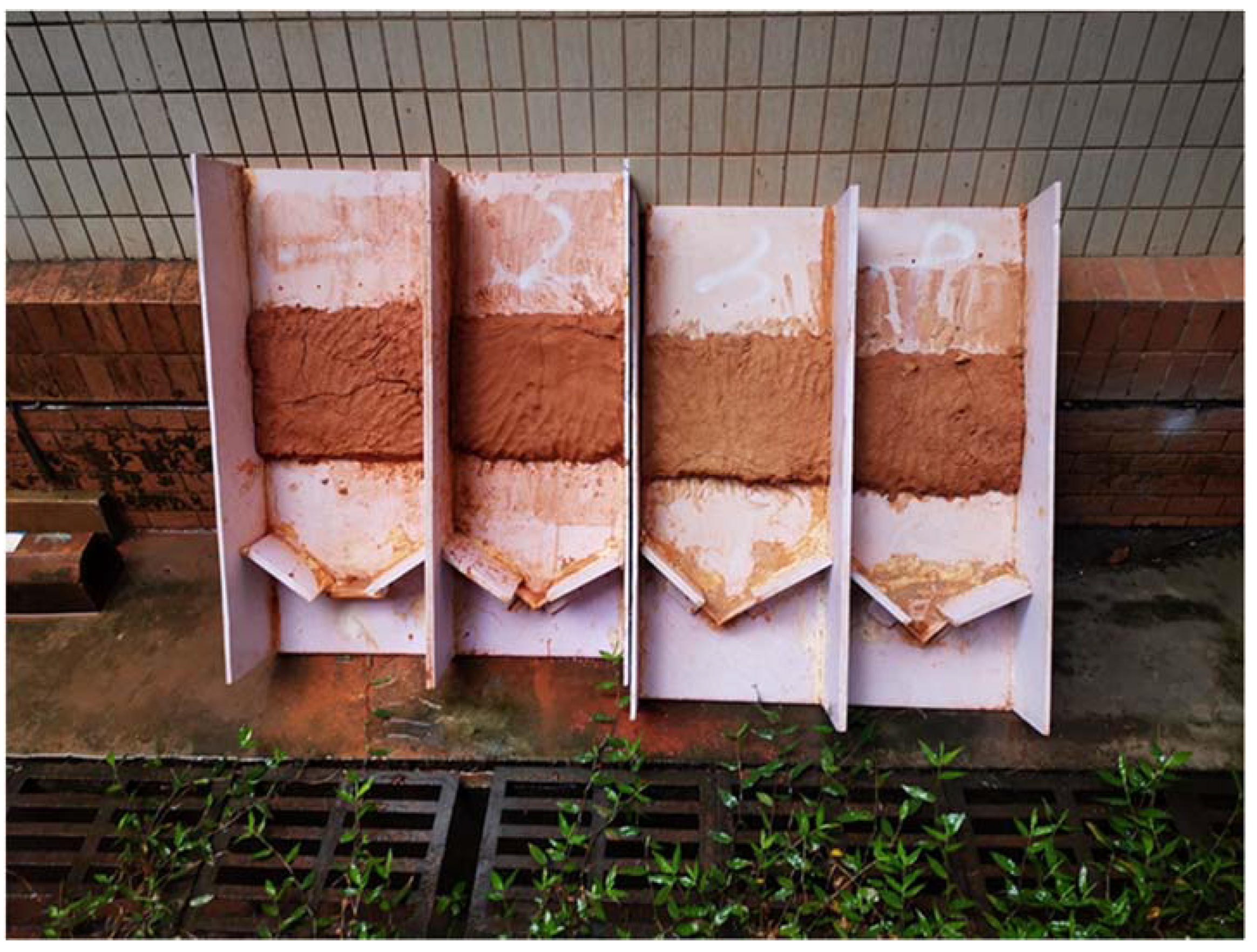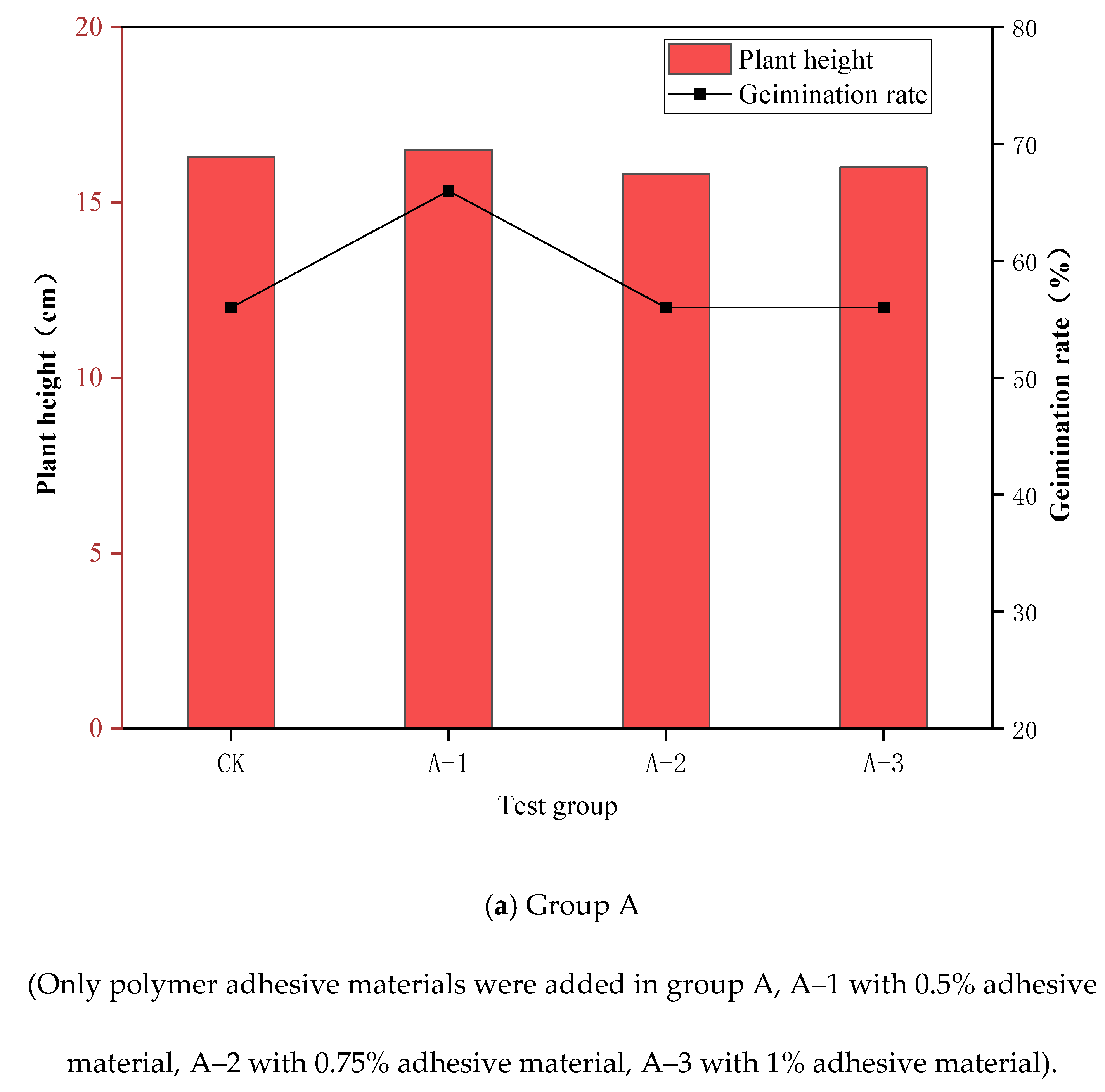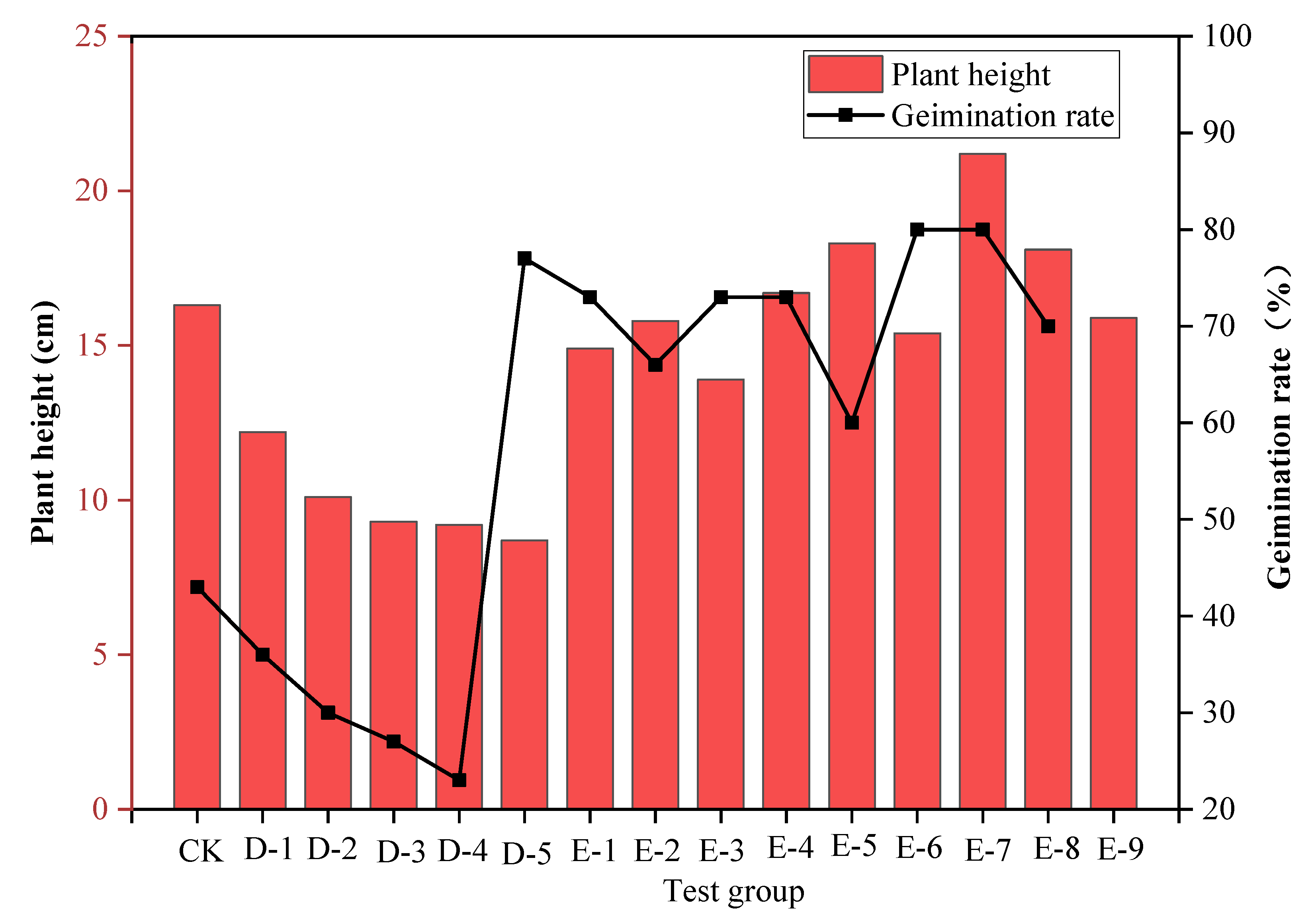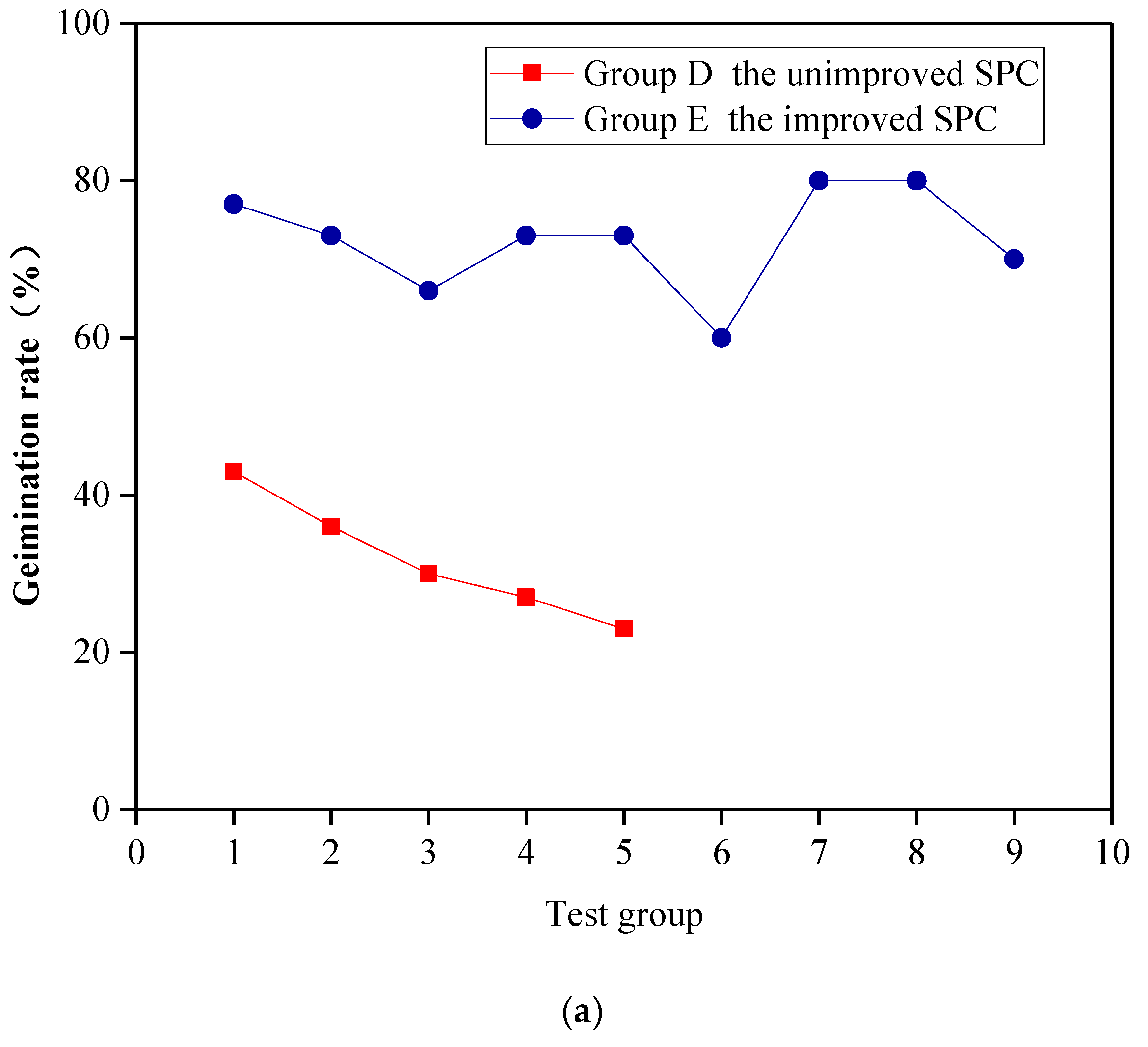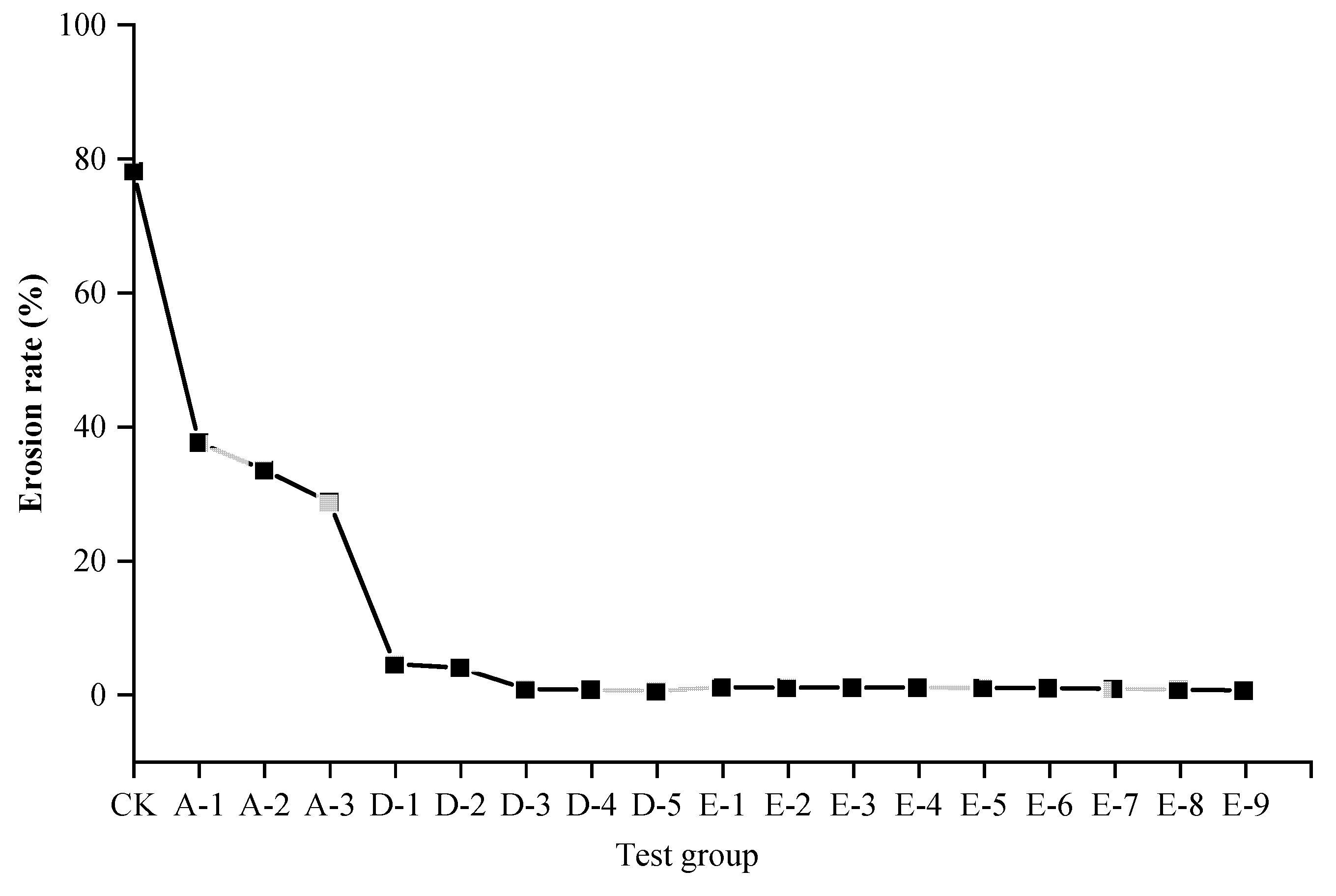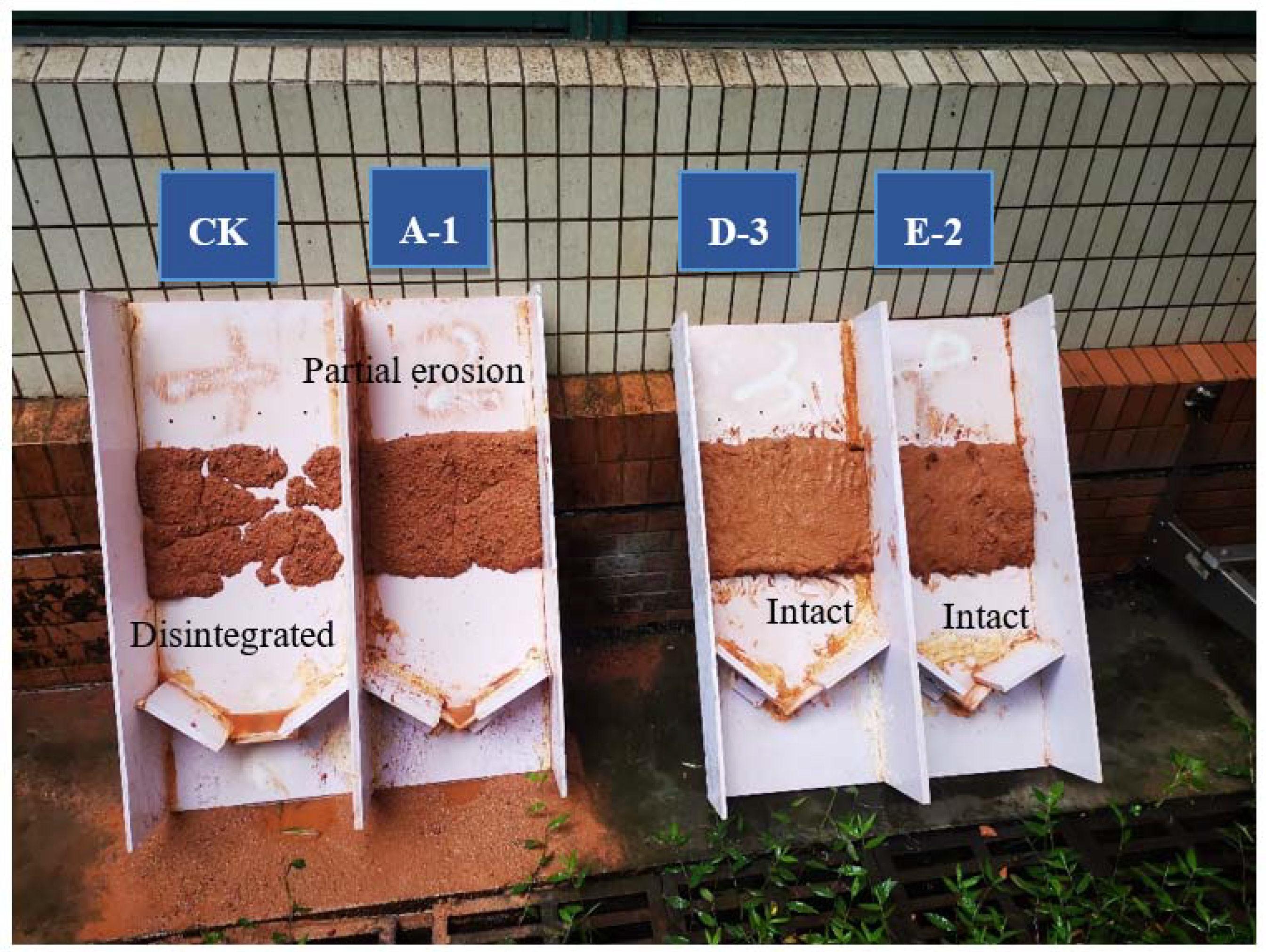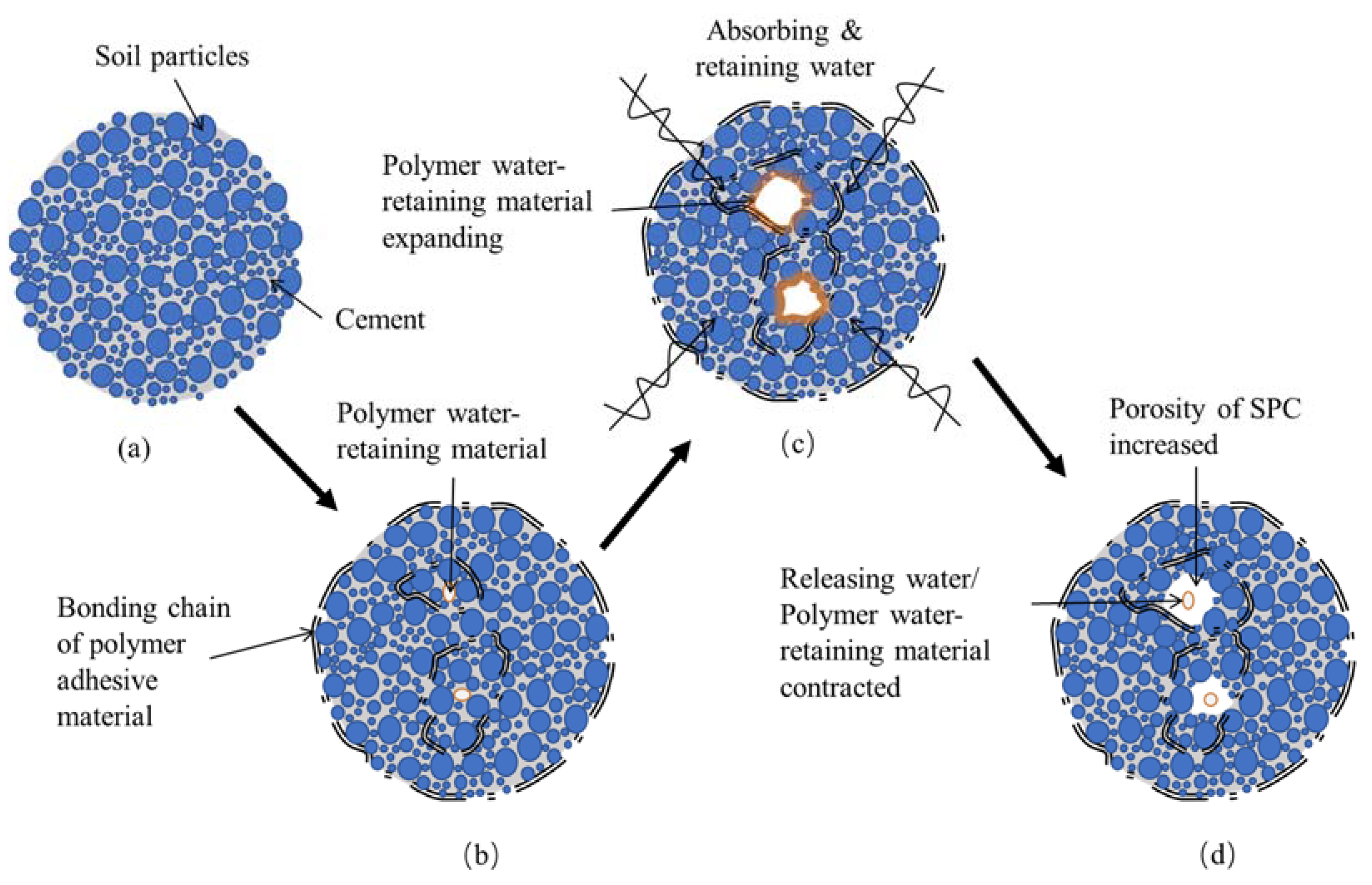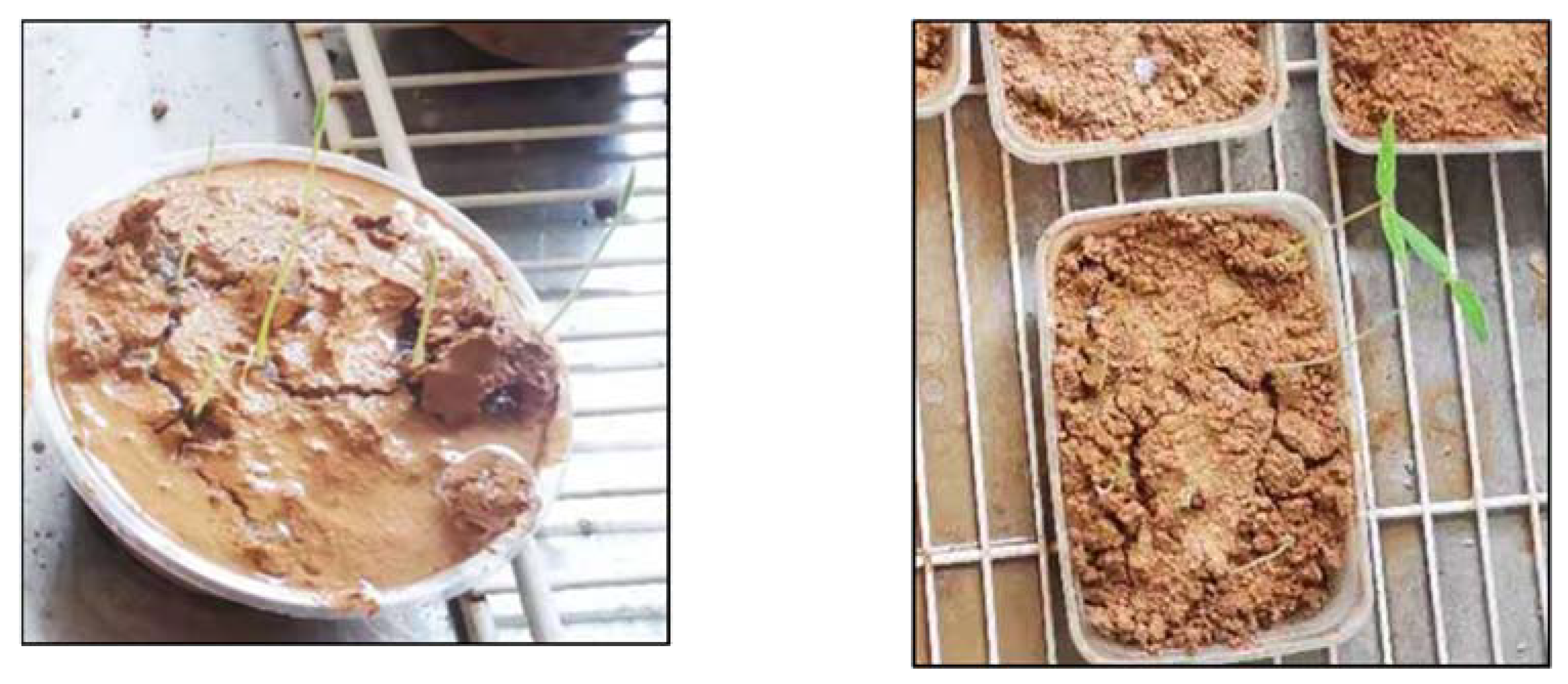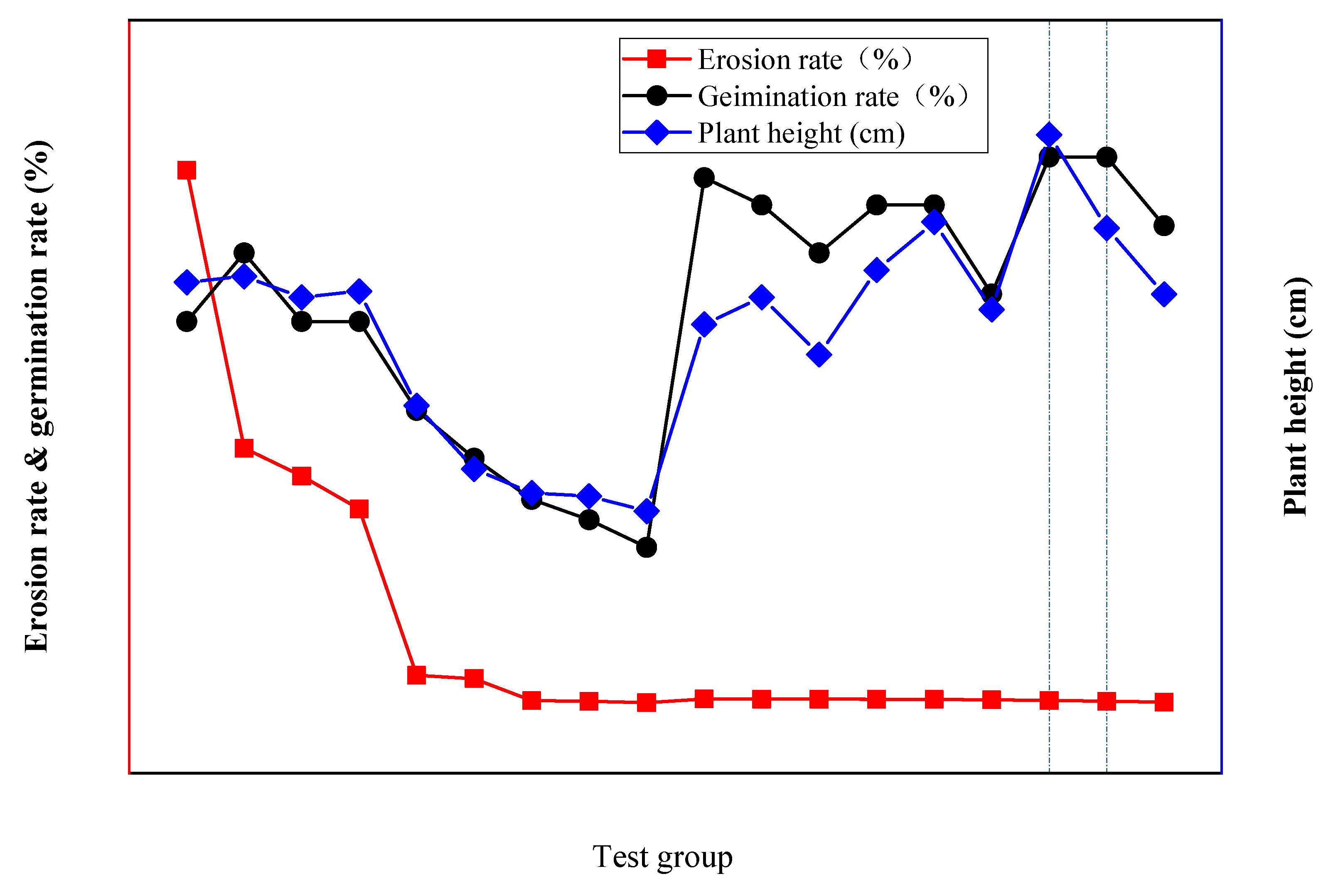3.3.1. Improvement Mechanism of Ecological Performance of SPC by Polymer Composite Material
The addition of cement makes the internal soil particles of SPC closely consolidated and firm as a whole (as shown in
Figure 10a), meaning SPC has superb erosion resistance. However, the addition of cement can inhibit plant growth in SPC and can cause problems of high alkalinity, overheating, and excessive hardening. Therefore, polymer composite material can be used to reduce the cement content in SPC, thereby alleviating these problems and improving SPC’s pore structure and porosity, preventing it from excessive hardening, improving the plant growth environment, and enhancing its ecological performance.
The molecular chain of the polymer adhesive material contains a large number of hydrophilic groups (-OOCCH
3), which can bind with the cations in the soil and establish physical and chemical bonds between the soil particles to connect the soil particles and make them form soil aggregates [
34] (as shown in
Figure 10b), which can improve the stability and erosion resistance performance of the soil [
35].
It can be seen from the results of the erosion resistance test that the erosion resistance of the soil samples was significantly enhanced under the improvement of the polymer adhesive material [
31,
35], and the addition of polymer adhesive materials did not produce any substances harmful to the soil environment. Hence, in terms of ecological slope protection, polymer adhesive material could well replace the role of cement in SPC, which can reduce the cement content of SPC and improve its ecological performance while maintaining its excellent erosion resistance performance.
The polymer water-retaining material can store a large amount of water in its molecular long chain and absorb and retain water when the water in the environment is sufficient. During this process, the water-retaining material expands greatly and exerts extrusion pressure on the surrounding soil (as shown in
Figure 10c). When the soil moisture gradually decreases, the water in the polymer water-retaining material is released slowly under the adsorption force of the surrounding soil particles and contracts near its original volume [
26]. The volume expansion and contraction of the polymer water-retaining material during the water absorption and release process lead to an increase in the SPC pores (as shown in
Figure 10d), thus playing the role of fluffing the SPC; improving the soil’s porosity and the permeability of the SPC (as shown in
Figure 11) and avoiding the problem of the excessive hardening of the SPC. Moreover, the addition of the water-retaining material enhances the SPC’s water retention and storage capacity, creating a better condition for plant growth and development. In summary, SPC improved by the addition of polymer composite material can satisfy the requirements of erosion resistance and water and soil loss, and this can improve its ecological performance to a higher level so that the SPC can become a good ecological restoration material for steep rocky slopes.
3.3.2. Improvement Effects of Polymer Composite Material on SPC
To further explore the improvements of polymer composite material on SPC, a range analysis, correlation analysis, and multiple regression analysis were carried out using the test results of the unimproved SPC in group D and the improved SPC in group E. The multiple regression equation was established to study the improvement laws of polymer composite material on SPC, which can play an important guiding role in the practical application and promotion of improved SPC.
In the range analysis, indicator reflects the influence of the test material on the test index such as erosion resistance performance, which can determine the optimal dosage of the test material and the optimal material ratio. As for the indicator R, the larger the R-value, the greater the influence of the test material on the test index and therefore, the more influential it is. The indicator R can be used to determine the influence of the test material on the test index from large to small.
The range analysis was carried out on the erosion resistance test results of groups D and E. The influence of the added polymer adhesive material, polymer water-retaining material, and cement on the SPC’s erosion resistance performance was explored and the optimal ratio of these materials was obtained. The results are shown in
Table 5.
From the range analysis results, the influence of the three materials on the erosion resistance performance of SPC was as follows, from large to small: cement > polymer adhesive material > polymer water-retaining material. To improve the erosion resistance performance of SPC, the optimal material ratio was found to be the material ratio of test group E-9. Compared with cement, according to the analysis, the polymer adhesive material also showed a strong soil consolidation capacity and can play a significant role in enhancing the erosion resistance performance of SPC.
A range analysis of the results of the plant growth test for groups D and E was carried out to analyze the impact of the addition of polymer adhesive material, polymer water-retaining material, and cement on the plant growth environment of the SPC, and the optimal ratio of material for use in SPC was obtained. The range analysis results are shown in
Table 6.
As the range analysis results show, the influence of the three materials on the improvement of the plant growth of SPC was as follows, from large to small: polymer water-retaining material > polymer adhesive material > cement. For plant growth, the optimal material ratio was that of test group E-3. From the analysis results, it can be inferred that the polymer adhesive material and the water-retaining material are more conducive to plant growth and development than the cement.
The regression equation was established at a 95% confidence interval to further explore the effects of polymer composite material on the improvement of SPC, taking the additional amounts of polymer adhesive material, cement, and polymer water-retaining material as variables x
1, x
2, and x
3, and the erosion rate, germination rate, and plant height when using SPC as dependent variables y
1, y
2, and y
3, y = Ax
1 + Bx
2 + Cx
3 + D, A, B, and C are the correlation coefficient. The analysis result is shown in
Table 7. The relationship between the dependent variable x and the independent variable y of all the regression equations reached a very significant level (
p-value < 0.01 or
p-value < 0.05). The dependent variable x had a significant impact on the independent variable y, meaning all the regression equations were valid.
It can be inferred from the regression equation that the polymer adhesive material x1 plays a role in improving the plant growth conditions and erosion resistance performance of SPC; the cement x2 is conducive to the erosion resistance performance of SPC but unfavorable to plant growth and the polymer water-retaining material x3 is disadvantageous to the erosion resistance performance of SPC but can significantly improve the plant growth of SPC. In particular, it can be seen from Formula (3) that the soil consolidation effect of the polymer adhesive material x1 per unit content is even better than that of the cement x2 per unit content. It can be deduced from Formula (4) and (5) that the polymer composite material can greatly improve the plant growth environment of SPC. In conclusion, the polymer composite material can improve SPC’s ecological performance and allow it to become an excellent material for slope ecological restoration with superb erosion resistance that is favorable to plant growth.
Summarizing the above experimental study and discussion, evidently, there is an optimal material ratio for the improvement of SPC with the addition of polymer composite material (as shown in
Figure 12). The erosion rate of the improved SPC in test groups E-7 and E-8 was low, and the germination rates and plant heights were high, which means that the improved SPC in test groups E-7 and E-8 demonstrated outstanding erosion resistance capacity and good ecological performance. While the erosion resistance performance of the improved SPC in group E-6 was also superior, its ecological performance was subpar. When using polymer composite materials to improve SPC, it is necessary to comprehensively consider the relevant situation and select an optimal material ratio according to the relevant test results. Considering the requirements for erosion resistance capacity and plant growth in this study, the optimal material ratio of the improved SPC in South China was found to be that of test group E-7, which is 7% cement, 0.5% polymer adhesive material, and 0.25% polymer water-retaining material in the outside soil.
